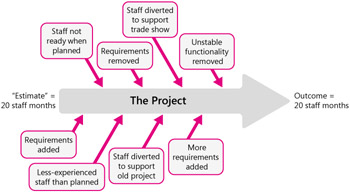1.6 Estimates and Project Control
|
|
1.6 Estimates and Project Control
Sometimes when people discuss software estimation they treat estimation as a purely predictive activity. They act as though the estimate is made by an impartial estimator, sitting somewhere in outer space, disconnected from project planning and prioritization activities.
In reality, there is little that is pure about software estimation. If you ever wanted an example of Heisenberg's Uncertainty Principle applied to software, estimation would be it. (Heisenberg's Uncertainty Principle is the idea that the mere act of observing a thing changes it, so you can never be sure how that thing would behave if you weren't observing it.) Once we make an estimate and, on the basis of that estimate, make a commitment to deliver functionality and quality by a particular date, then we control the project to meet the target. Typical project control activities include removing non-critical requirements, redefining requirements, replacing less-experienced staff with more-experienced staff, and so on. Figure 1-9 illustrates these dynamics.

Figure 1-9: Projects change significantly from inception to delivery. Changes are usually significant enough that the project delivered is not the same as the project that was estimated. Nonetheless, if the outcome is similar to the estimate, we say the project met its estimate.
In addition to project control activities, projects are often affected by unforeseen external events. The project team might need to create an interim release to support a key customer. Staff might be diverted to support an old project, and so on.
Events that happen during the project nearly always invalidate the assumptions that were used to estimate the project in the first place. Functionality assumptions change, staffing assumptions change, and priorities change. It becomes impossible to make a clean analytical assessment of whether the project was estimated accurately—because the software project that was ultimately delivered is not the project that was originally estimated.
In practice, if we deliver a project with about the level of functionality intended, using about the level of resources planned, in about the time frame targeted, then we typically say that the project "met its estimates," despite all the analytical impurities implicit in that statement.
Thus, the criteria for a "good" estimate cannot be based on its predictive capability, which is impossible to assess, but on the estimate's ability to support project success, which brings us to the next topic: the Proper Role of Estimation.
|
|
EAN: 2147483647
Pages: 212